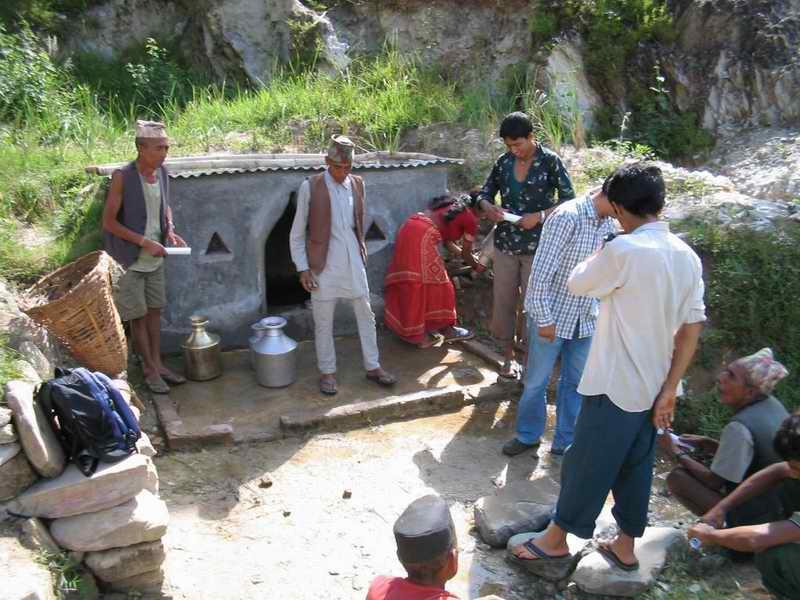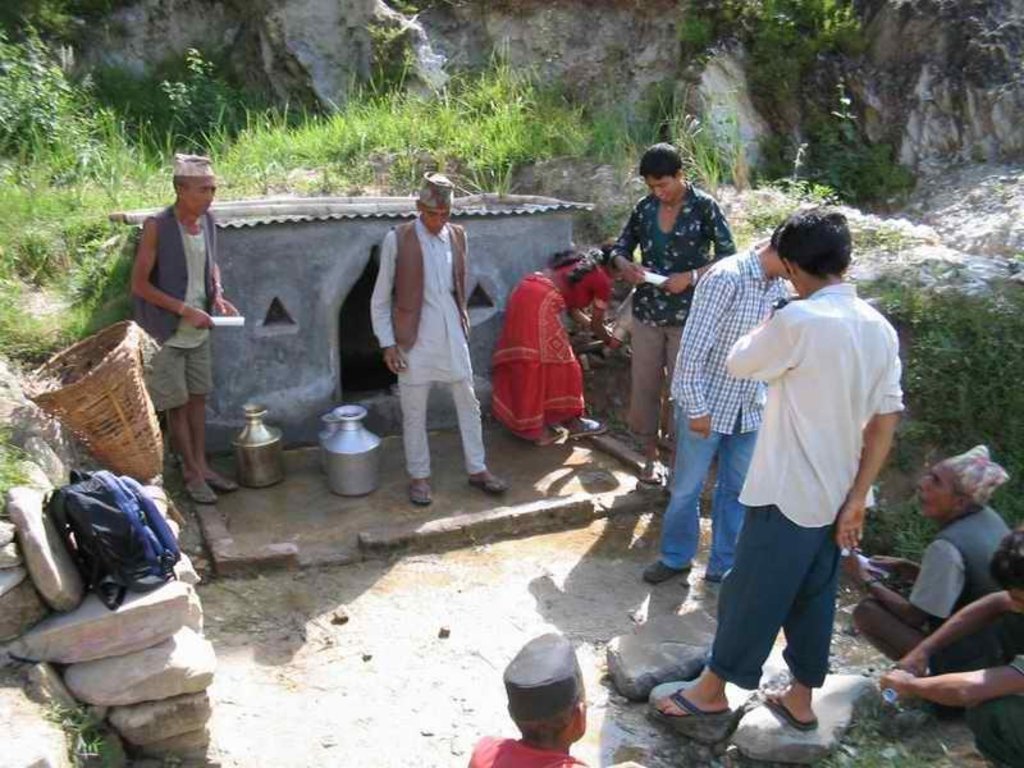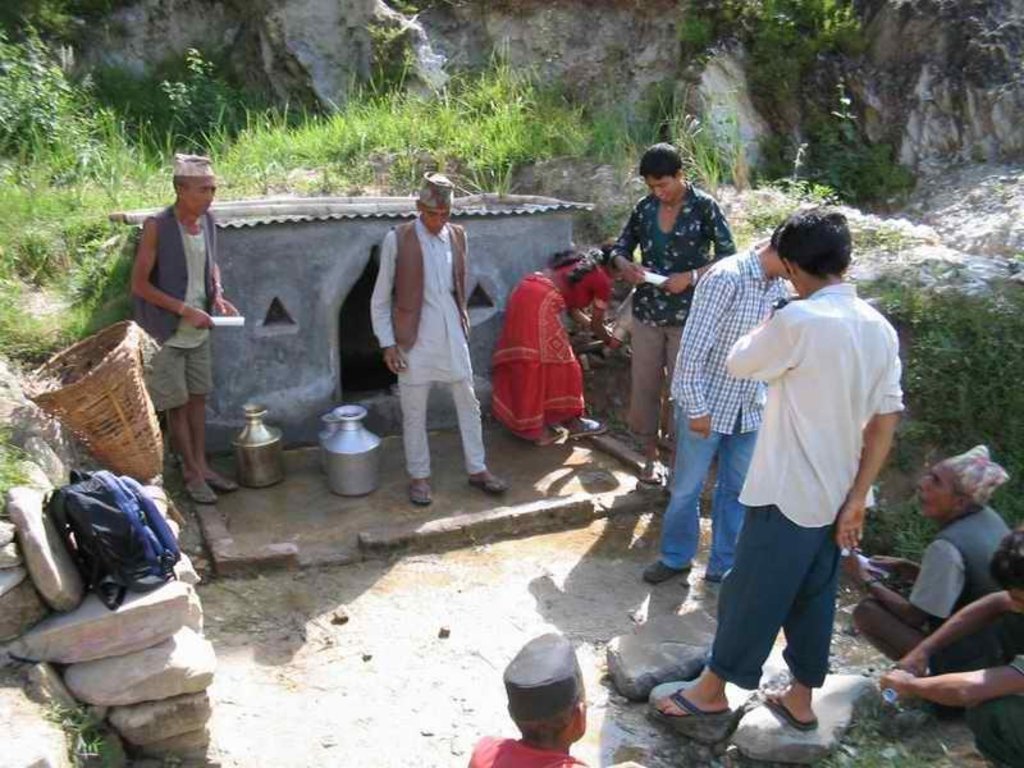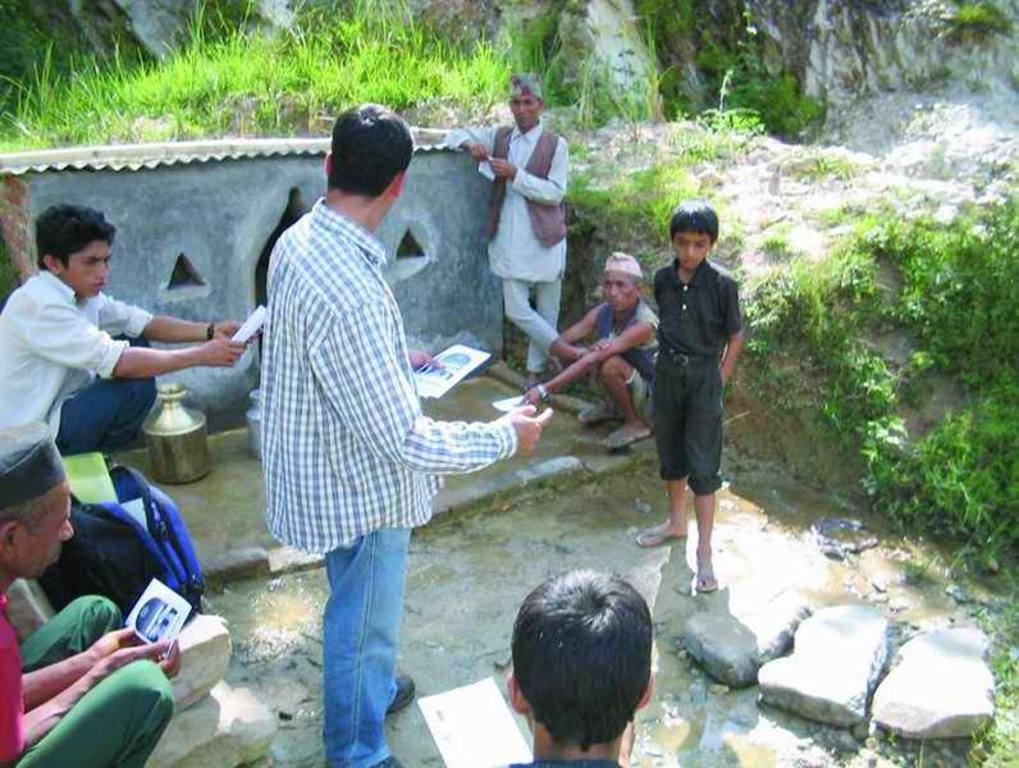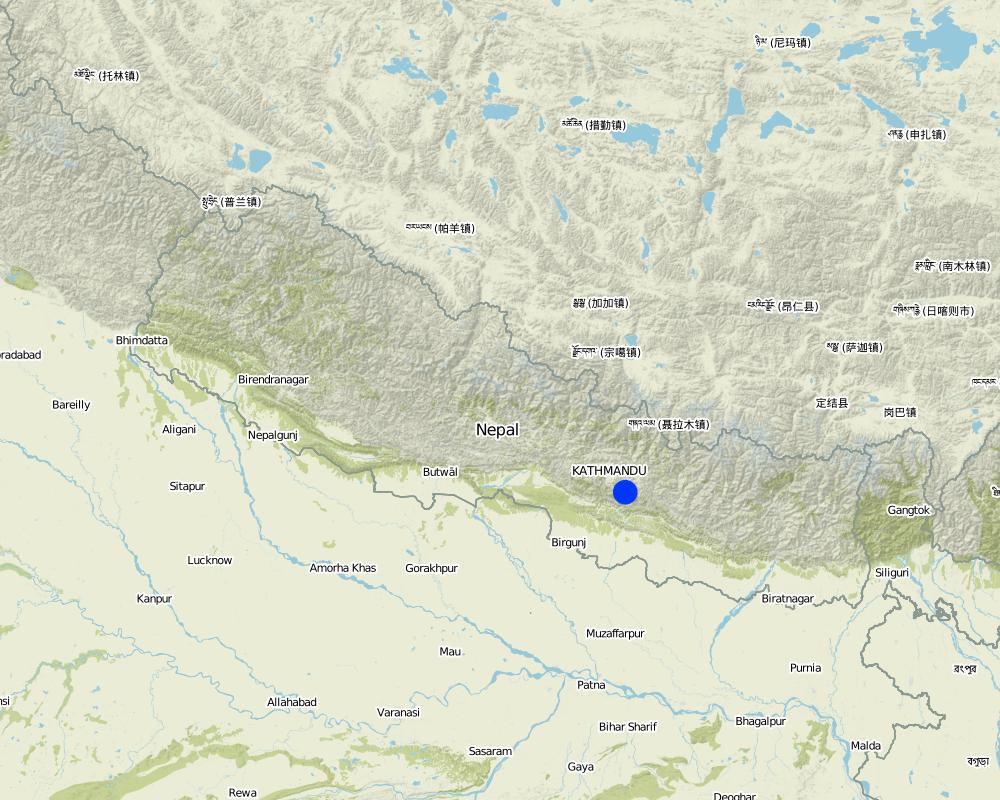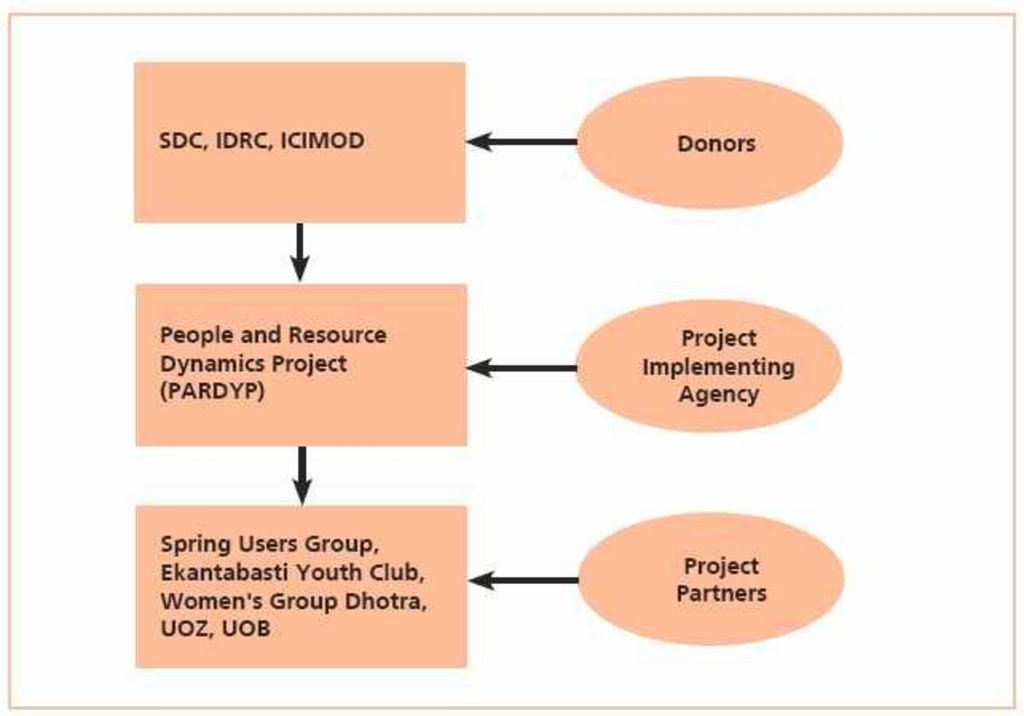Community efforts for improving drinking water quality [ប្រទេសនេប៉ាល់]
- ការបង្កើត៖
- បច្ចុប្បន្នភាព
- អ្នកចងក្រង៖ Madhav Dhakal
- អ្នកកែសម្រួល៖ –
- អ្នកត្រួតពិនិត្យ Fabian Ottiger
Piune paani ko gunastar sudhar ka lagi samudayik prayas
approaches_2352 - ប្រទេសនេប៉ាល់
ពិនិត្យមើលគ្រប់ផ្នែក
ពង្រីកមើលទាំងអស់ បង្រួមទាំងអស់1. ព័ត៌មានទូទៅ
1.2 ព័ត៌មានលម្អិតពីបុគ្គលសំខាន់ៗ និងស្ថាប័នដែលចូលរួមក្នុងការវាយតម្លៃ និងចងក្រងឯកសារនៃវិធីសាស្ត្រផ្សព្វផ្សាយ
អ្នកជំនាញឯកទេស SLM:
Isabelle Provodoli
himcat@icimod.org
International Centre for Integrated Mountain Development (ICIMOD), GPO
Box. 3226, Kathmandu
ប្រទេសនេប៉ាល់
ឈ្មោះអង្គភាពមួយ (ច្រើន) ដែលបានចងក្រងឯកសារ/ វាយតម្លៃលើវិធីសាស្ត្រផ្សព្វផ្សាយ (បើទាក់ទង)
CDE Centre for Development and Environment (CDE Centre for Development and Environment) - ប្រទេសស្វ៊ីសឈ្មោះអង្គភាពមួយ (ច្រើន) ដែលបានចងក្រងឯកសារ/ វាយតម្លៃលើវិធីសាស្ត្រផ្សព្វផ្សាយ (បើទាក់ទង)
ICIMOD International Centre for Integrated Mountain Development (ICIMOD) - ប្រទេសនេប៉ាល់1.3 លក្ខខណ្ឌទាក់ទងទៅនឹងការប្រើប្រាស់ទិន្នន័យដែលបានចងក្រងតាមរយៈវ៉ូខេត
អ្នកចងក្រង និង(បុគ្គលសំខាន់ៗ)យល់ព្រមទទួលយកនូវលក្ខខណ្ឌនានាទាក់ទងទៅនឹងការប្រើប្រាស់ទិន្នន័យដែលបានចងក្រងតាមរយៈ វ៉ូខេត:
បាទ/ចា៎
1.4 ការយោងមួយ (ច្រើន) ទៅលើ (កម្រង) បញ្ជីសំណួរនៃបច្ចេកទេស SLM
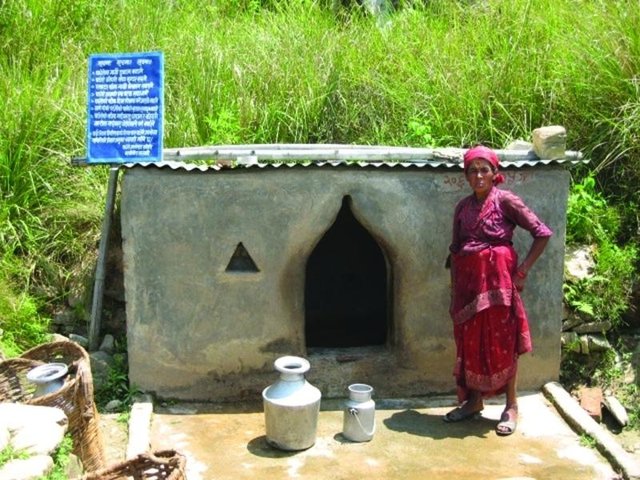
Drinking water quality improvement through conservation measures [ប្រទេសនេប៉ាល់]
Structural and vegetative measures to improve the quality of drinking water contaminated due to poor sanitation and seepage
- អ្នកចងក្រង៖ Madhav Dhakal
2. ការពណ៌នាអំពីវិធីសាស្ត្រផ្សព្វផ្សាយ SLM
2.1 ពណ៌នាសង្ខេបខ្លីពីវិធីសាស្ត្រផ្សព្វផ្សាយ
Working with communities to demonstrate and disseminate methods for improving drinking water quality using structural and vegetative measures
2.2 ពណ៌នាលម្អិតពិវិធីសាស្ត្រផ្សព្វផ្សាយ
ពណ៌នាលម្អិតពិវិធីសាស្ត្រផ្សព្វផ្សាយ:
Aims / objectives: The People and Resource Dynamics in Mountain Watersheds of the Hindu Kush- Himalayas Project (PARDYP) implemented this approach with 30 drinking water user households at Barbot in the Jhikhu Khola watershed, Kavre Palanchok. The aim was to improve water quality and availability from an open spring source through participatory planning and implementation. The approach first identified local concerns and observed the sanitary situation of the catchment area. Meetings were held jointly with men and women users from different caste groups (Brahmin, Chhetri, Newar and Kami) to discuss the problems and issues and to identify viable solutions. The advantages and disadvantages of the various options were discussed, after which users selected the following three measures to improve the drinking water supply: 1) building a brick-cement walled structure around the main local spring, 2) establishing check dams across nearby rills and gullies, and 3) planting grass around the spring box and tree saplings within the catchment area. The aim was to prevent direct flow of surface water into the spring and reduce contamination and turbidity of the source. Understanding and support was gained by demonstrating the technology and running an awareness campaign.
Role of stakeholders: The project helped form a users committee made up of 11 women and 1 man and encouraged them to plant grass and tree seedlings across the entire catchment. The project regularly measured the quality of the water and shared the results with the users. Rules and regulations were developed to ensure equitable access to the spring and its sustainable use and management. A notice board with do’s and don’ts was placed near the spring. The users held monthly meetings and established a revolving fund for maintaining the structures. Spring users followed the rules and regulations by washing, cleaning, and bathing at separate sources. Livestock grazing was stopped in the nearby area and the area was regularly cleaned. Furthermore, users were encouraged to treat water for drinking using simple methods like SODIS and the low cost Safa filter to avoid microbiological contamination. They were made more aware of water quality, sanitation, and health issues.
2.3 រូបភាពនៃវិធីសាស្ត្រផ្សព្វផ្សាយ
2.5 ប្រទេស/តំបន់/ទីតាំងកន្លែង ដែលវិធីសាស្ត្រផ្សព្វផ្សាយត្រូវបានអនុវត្តន៍
ប្រទេស:
ប្រទេសនេប៉ាល់
បញ្ជាក់បន្ថែមពីលក្ខណៈនៃទីតាំង:
Kavrepalanchowk district/ Jhikhu Kholawatershed
Map
×2.6 កាលបរិច្ឆេទនៃការចាប់ផ្តើម និងបញ្ចប់នៃវិធីសាស្រ្តផ្សព្វផ្សាយនេះ
ឆ្នាំបញ្ចប់ (ប្រសិនបើវិធីសាស្ត្រផ្សព្វផ្សាយត្រូវបានឈប់ប្រើប្រាស់):
2005
2.7 ប្រភេទនៃវិធីសាស្ត្រផ្សព្វផ្សាយ
- ផ្អែកលើគម្រោង/កម្មវិធី
2.8 គោលបំណង/ទិសដៅសំខាន់នៃវិធីសាស្ត្រផ្សព្វផ្សាយ
The Approach focused on SLM only
- To explore and demonstrate appropriate water quality improving technologies and methods in a participatory way. - To increase awareness on water quality, water treatment, and health and hygiene. - To share knowledge gained on the water improvement options with farmers and other stakeholders
The SLM Approach addressed the following problems: Weak institutional collaboration to develop technological options for improving drinking water quality and availability and to raise awareness on health and hygiene and waterborne diseases.
2.9 លក្ខខណ្ឌអនុញ្ញាត ឬរារាំងការអនុវត្តន៍បច្ចេកទេសដែលស្ថិតនៅក្រោមវិធីសាស្រ្តផ្សព្វផ្សាយ
ភាពអាចរកបាននៃធនធានហិរញ្ញវត្ថុ និងសេវាកម្ម
- រារាំង
For the maintenance of the implemented technology
Treatment through the SLM Approach: Revolving fund collected by users
បរិបទនៃស្ថាប័ន
- រារាំង
Weak institutional collaboration
Treatment through the SLM Approach: User group formed linking local community organisations
ក្របខណ្ឌច្បាប់ (សិទ្ធិកាន់កាប់ដីធ្លី កម្មសិទ្ធីប្រើប្រាស់ដីនិងទឹក)
- អំណោយផល
The existing land ownership, land use rights / water rights greatly helped the approach implementation: mostly state owned land and some private land - which helped implementating the technology as there was no conflict.
ចំណេះដឹងស្តីពី SLM និងការទទួលបានការគាំទ្រផ្នែកបច្ចេកទេស
- រារាំង
Different water treatment methods
Treatment through the SLM Approach: Awareness of structural and vegetative measures; direct water treatment methods including Safa filter, SODIS, chlorination
3. ការចូលរួម និងតួនាទីរបស់ភាគីពាក់ព័ន្ធ
3.1 អ្នកពាក់ព័ន្ធដែលបានចូលរួមក្នុងវិធីសាស្ត្រផ្សព្វផ្សាយ និងតួនាទីរបស់ពួកគេ
- អ្នកប្រើប្រាស់ដីក្នុងតំបន់/សហគមន៍
Land users worked equally divided between men and women
Improvement of drinking water quality and quantity was the major concern of all spring users.
- អង្គការក្រៅរដ្ឋាភិបាល
- រដ្ឋាភិបាលថ្នាក់ជាតិ (អ្នករៀបចំផែនការ អ្នកសម្រេចចិត្ត)
- អង្គការអន្តរជាតិ
PARDYP/ICIMOD
ប្រសិនមានភាគីពាក់ព័ន្ធច្រើនចូលរួមសូមចង្អុលបង្ហាញភ្នាក់ងារដែលនាំមុខគេ:
Concept designed by national specialist and implemented jointly with users
3.2 ការចូលរួមរបស់អ្នកប្រើប្រាស់ដីក្នុងតំបន់/ សហគមន៍ក្នុងតំបន់ក្នុងដំណាក់កាលផ្សេងគ្នានៃវិធីសាស្រ្តផ្សព្វផ្សាយ
| ការចូលរួមរបស់អ្នកប្រើប្រាស់ដីក្នុងតំបន់/សហគមន៍ក្នុងតំបន់ | សូមបញ្ជាក់នរណាត្រូវបានចូលរួម ព្រមទាំងពណ៌នាសកម្មភាពទាំងនោះ | |
|---|---|---|
| ការចាប់ផ្តើម/ការលើកទឹកចិត្ត | អន្តរកម្ម | public meetings; meetings organised to identify problems and possible options to overcome them. |
| ការរៀបចំផែនការ | អន្តរកម្ម | public meetings; organised regularly to identify implementing steps, and role and responsibility of different stakeholders in overcoming problems |
| ការអនុវត្តន៍ | អន្តរកម្ម | responsibility for major steps; the user group responsible for implementation and the project for technical support |
| ការត្រួតពិនិត្យ និងវាយតម្លៃ | អន្តរកម្ម | The quality of the water was measured in each season to monitor the impact of the technology. Detailed progress reports, results, and lessons learned were shared with district level institutions and authorities, water quality reports were shared with spring users at public meetings |
| Research | អសកម្ម | Water quality and availability recorded before and after technology implemented. Studies on access to water and confl icts among users |
3.3 គំនូសបំព្រួញ (ប្រសិនបើមាន)
ការពណ៌នា:
PARDP project donors and implementing partners-- SDC: Swiss Agency for Development and Cooperation IDRC: International Development Research Centre ICIMOD: International Centre for Integrated Mo
អ្នកនិពន្ធ:
Madhav Dhakal
3.4 ការសម្រេចចិត្តលើការជ្រើសរើសបច្ចេកទេស SLM
សូមបញ្ជាក់តើអ្នកណាជាអ្នកបានសម្រេចចិត្តក្នុងការជ្រើសរើសបច្ចេកទេសដើម្បីយកមកអនុវត្តន៍:
- អ្នកប្រើប្រាស់ដី ដោយមានការគាំទ្រពីអ្នកជំនាញឯកទេស SLM
ចូរពន្យល់:
Users selected three of the potential conservation options.
Decisions on the method of implementing the SLM Technology were made by mainly by land users supported by SLM specialists. The technology and associated measures were not new to the area and the implementing methods were simple and have been practised for a long time. The project initiated the formation of a users committee and the committee conducted the conservation activities.
4. ជំនួយបច្ចេកទេស ការកសាងសមត្ថភាព និងការគ្រប់គ្រងចំណេះដឹង
4.1 ការកសាងសមត្ថភាព/ បណ្តុះបណ្តាល
តើវគ្គបណ្តុះបណ្តាលបានផ្តល់ឱ្យអ្នកប្រើប្រាស់ដី/អ្នកពាក់ព័ន្ធផ្សេងៗទៀតដែរឬទេ?
បាទ/ចា៎
សូមបញ្ជាក់តើអ្នកណាត្រូវបានបណ្តុះបណ្តាល:
- អ្នកប្រើប្រាស់ដី
ទម្រង់នៃការបណ្តុះបណ្តាល:
- ការប្រជុំជាសាធារណៈ
ប្រធានបទបណ្តុះបណ្តាល:
Concept of conservation measures, and methods of treating contaminated water using SODIS and safa filter.
4.2 សេវាផ្តល់ប្រឹក្សាយោបល់
តើអ្នកប្រើប្រាស់ដីបានទទួលនូវសេវាផ្តល់ប្រឹក្សាដែរ ឬទេ?
បាទ/ចា៎
សូមបញ្ជាក់ប្រសិនបើសេវាកម្មប្រឹក្សាយោបល់ត្រូវបានផ្តល់ឱ្យ:
- នៅលើដីរបស់អ្នកប្រើប្រាស់ដី
ពណ៌នា/ពន្យល់:
Name of method used for advisory service: Sharing information on water quality status, and raising awareness among users.; Key elements: catchment conservation, health hygiene, water treatment methods; 1) Advisory service was carried out through: projects own extension structure and agents; Extension staff: specifically hired project employees 2) Target groups for extension: land users; Activities: awareness on health hygiene; catchment conservation activities and water treatment methods were shared during meetings.
Advisory service is quite adequate to ensure the continuation of land conservation activities
4.3 ការពង្រឹងសមត្ថភាពស្ថាប័ន (ការអភិរឌ្ឍន៍អង្គភាព)
តើស្ថាប័នទាំងអស់ត្រូវបានបង្កើតឡើង ឬពង្រឹងសមត្ថភាពតាមរយៈវិធីសាស្ត្រផ្សព្វផ្សាយដែរ ឬទេ?
- បាទ/ច៎ា តិចតួច
សូមបញ្ជាក់ថាតើស្ថាប័នត្រូវបានពង្រឹង ឬបង្កើតឡើងនៅត្រឹមកម្រិតណា(ច្រើន)?
- ថ្នាក់មូលដ្ឋាន
សូមបញ្ជាក់ប្រភេទនៃការគាំទ្រ:
- ការកសាងសមត្ថភាព/ បណ្តុះបណ្តាល
សូមផ្តល់ព័ត៌មានបន្ថែមទៀតឱ្យបានលម្អិត:
Training on water quality treatment provided to local club
4.4 ការត្រួតពិនិត្យ និងវាយតម្លៃ
តើការត្រួតពិនិត្យ និងវាយតម្លៃគឺជាផ្នែកមួយនៃវិធីសាស្ត្រដែរឬទេ?
បាទ/ចា៎
មតិយោបល់:
bio-physical aspects were ad hoc monitored through observations; indicators: land use and degradation, sanitary inspection, history of spring, available resources to trap water
technical aspects were regular monitored through measurements; indicators: seasonal water quality and discharge
socio-cultural aspects were ad hoc monitored through observations; indicators: number of spring users, household water requirements, users' issues
no. of land users involved aspects were regular monitored through measurements; indicators: participation in conservation activities
There were few changes in the Approach as a result of monitoring and evaluation: The project consulted with the local women's cooperative to solve a conflict over water quantity and access to spring source.
4.5 ការស្រាវជ្រាវ
តើការស្រាវជ្រាវ គឺជាផ្នែកមួយនៃវិធីសាស្រ្តដែរឬទេ?
បាទ/ចា៎
បញ្ជាក់ប្រធានបទ:
- សង្គមវិទ្យា
- បច្ចេកវិទ្យា
សូមផ្តល់ព័ត៌មានបន្ថែមទៀតឱ្យបានលម្អិត និងចង្អុលបង្ហាញនរណាដែលបានធ្វើការស្រាវជ្រាវ:
Access to drinking water, conflicts at water fetching times, water quality and quantity measurement, and effectiveness of water treatment methods.
Research was carried out on station
5. ថវិកា និងសម្ភារៈឧបត្ថម្ភពីខាងក្រៅ
5.1 ថវិកាប្រចាំឆ្នាំសម្រាប់ផ្សព្វផ្សាយ SLM
ប្រសិនបើចំនួនពិតប្រាកដនៃថវិកាប្រចាំឆ្នាំមិនត្រូវបានដឹងច្បាស់ សូមប្រាប់ពីចន្លោះនៃថវិកានោះ:
- < 2,000
មតិយោបល់ (ឧ. ប្រភពសំខាន់នៃមូលនិធិ/ម្ចាស់ជំនួយចំបង):
Approach costs were met by the following donors: international (SDC, IDRC, ICIMOD): 90.0%; local community / land user(s) (users group): 10.0%
5.3 សូមបញ្ជាក់ពីធាតុចូលត្រូវបានផ្តល់បដិភាគ (រួមទាំងកម្លាំងពលកម្ម)
- ផ្សេងៗ
| ផ្សេងៗ (បញ្ចាក់) | កម្រិតទំហំប៉ុណ្ណា | សូមបញ្ជាក់ពីការបដិភាគ |
|---|---|---|
| Planting materials |
ប្រសិនបើកម្លាំងពលកម្មធ្វើដោយអ្នកប្រើប្រាស់ដី តើវាជាធាតុចូលដ៏សំខាន់មួយដែរ ឬទេ:
- ដោយស្ម័គ្រចិត្ត
មតិយោបល់:
In implementing the technology and the approach
5.4 ឥណទាន
តើឥណទានដែលបានផ្តល់នៅក្រោមវិធីសាស្ត្រផ្សព្វផ្សាយសម្រាប់សកម្មភាព SLM នេះយ៉ាងដូចម្តេច?
បាទ/ចា៎
6. ការវិភាគរកផលប៉ះពាល់ និងសេចក្តីសន្និដ្ឋាន
6.1 ផលប៉ះពាល់នៃវិធីសាស្ត្រផ្សព្វផ្សាយ
តើវិធីសាស្ត្រផ្សព្វផ្សាយជួយអ្នកប្រើប្រាស់ដីដើម្បីអនុវត្តន៍ និងថែទាំបច្ចេកទេស SLM?
- ទេ
- បាទ/ច៎ា បន្តិចបន្តួច
- បាទ/ច៎ា ជាមធ្យម
- បាទ/ច៎ា បានខ្លាំង
To build awareness on SLM and methods of improving drinking water quality. It also helped users to work in a group.
Did other land users / projects adopt the Approach?
- ទេ
- បាទ/ច៎ា បន្តិចបន្តួច
- បាទ/ច៎ា ជាមធ្យម
- បាទ/ច៎ា បានខ្លាំង
Similar approaches are being followed in other communities across Nepal.
6.2 ការលើកទឹកចិត្តចម្បងៗរបស់អ្នកប្រើប្រាស់ដីសម្រាប់ការអនុវត្តបច្ចេកទេស SLM
- កាត់បន្ថយទំហំការងារ
due to reduced water fetching time (or distance).
- ពង្រឹងស្មារតីផ្នែកបរិស្ថាន
Improved heath due to clean water and better sanitation
6.3 សកម្មភាពផ្សព្វផ្សាយដែលប្រកបដោយចីរភាព
តើអ្នកប្រើប្រាស់ដីអាចធ្វើឱ្យមានចីរភាពនូវអ្វីដែលត្រូវបានអនុវត្តន៍តាមរយៈវិធីសាស្ត្រផ្សព្វផ្សាយដែរឬទេ(ដោយពុំមានការគាំទ្រពីអ្នកខាងក្រៅ)?
- បាទ/ចា៎
ប្រសិនបាទ/ច៎ា សូមរៀបរាប់ថាធ្វើយ៉ាងម៉េច:
Users are maintaining the implemented technology and also protecting the other nearby spring sources.
6.4 ភាពខ្លាំង/ គុណសម្បត្តិនៃវិធីសាស្ត្រផ្សព្វផ្សាយ
| ភាពខ្លាំង/ គុណសម្បត្តិ/ ឱកាស ទស្សនៈរបស់អ្នកប្រើប្រាស់ដី |
|---|
| Water users committee formed, revolving fund collected, and rules and regulations developed for the sustainable management of the drinking water system (How to sustain/ enhance this strength: Maintain links with local community mobilisation groups for continuous guidance and support for the user group and for the proper use of the revolving fund.) |
| ភាពខ្លាំង/ គុណសម្បត្តិ/ ឱកាស ទស្សនៈរបស់បុគ្គលសំខាន់ៗ |
|---|
| Users have become more aware of sanitation issues than before (How to sustain/ enhance this strength: Awareness campaigns should be organized regularly covering more villages.) |
| Users have become more aware of 1) the quality of their drinking water, 2) its impact on their health, 3) water quality improvement options, and 4) the importance of soil and water conservation (How to sustain/ enhance this strength: Water quality testing campaigns should be continued and technical know how about different water quality treatment methods for improved health shared at regular meetings) |
6.5 ភាពខ្សោយ/ គុណវិបត្តិនៃវិធីសាស្ត្រ និងរកដំណោះស្រាយ
| ភាពខ្សោយ/ គុណវិបត្តិ/ ហានិភ័យ ទស្សនៈរបស់អ្នកប្រើប្រាស់ដី | តើបច្ចេកទេសទាំងនោះបានដោះស្រាយបញ្ហាដូចម្តេច? |
|---|---|
| Water aviallability is still insufficient during dry period (March -May) | Other available nearrer sources should also be used, catchment protection activities should be continued. |
| ភាពខ្សោយ/ គុណវិបត្តិ/ ហានិភ័យក្នុងទស្សនៈរបស់បុគ្គលសំខាន់ៗ | តើបច្ចេកទេសទាំងនោះបានដោះស្រាយបញ្ហាដូចម្តេច? |
|---|---|
| Conflicts are visible during the dry season due to insufficient quantity of water. | Good coordination among the group members should minimise conflicts- the strong and balanced role of users committee is vital for the equitable sharing of benefits. |
7. ឯកសារយោង និងវេបសាយ
7.1 វិធីសាស្ត្រ/ ប្រភពនៃព័ត៌មាន
- តាមការចុះទីវាល ការស្រាវជ្រាវនៅទីវាល
- ការសម្ភាសន៍ជាមួយអ្នកប្រើប្រាស់ដី
7.2 ឯកសារយោងដែលបានចេញផ្សាយ
ចំណងជើង អ្នកនិពន្ធ ឆ្នាំ ISBN:
ICIMOD (2007) Good Practices in Watershed Management, Lessons Learned in the Mid Hills of Nepal. Kathmandu: ICIMOD
មានប្រភពមកពីណា? ថ្លៃដើមប៉ុន្មាន?
ICIMOD
ការតភ្ជាប់ និងម៉ូឌុល
ពង្រីកមើលទាំងអស់ បង្រួមទាំងអស់ការតភ្ជាប់

Drinking water quality improvement through conservation measures [ប្រទេសនេប៉ាល់]
Structural and vegetative measures to improve the quality of drinking water contaminated due to poor sanitation and seepage
- អ្នកចងក្រង៖ Madhav Dhakal
ម៉ូឌុល
គ្មានម៉ូឌុល


